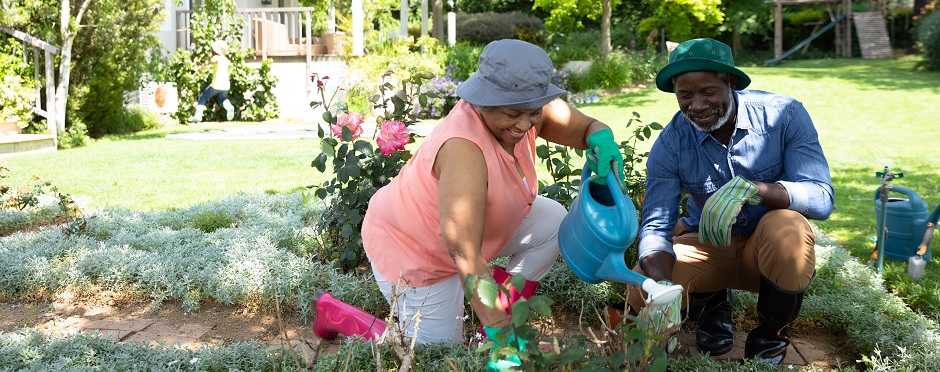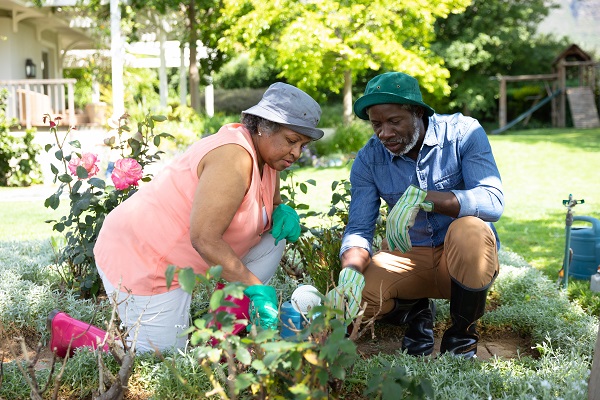
Guide to Gardening: 4 Tips to Conquer the Earth Pain-Free
1 CommentResearch shows that gardeners have decreased anxiety, depression, and body mass index (a measure of body fat percentage calculated by dividing one’s weight by height). Gardening, when done in community also promotes societal well-being. Many garden for yard maintenance, to grow food, or just for enjoyment. Although gardening is rewarding and good for your health, gardeners should still keep a few things in mind before conquering the earth. It is important to take precautions to protect your back, knees and arms from repetitive stress and injury. Here are just a few considerations to keep in mind.
1. Equipment and Tools
Before digging in, be sure to gather the correct tools and equipment. Many tools are designed to make the work you do easier and therefore, can protect your hands, joints, knees, etc.
- Gardening gloves to protect from blisters/cuts/infections and to decrease tight grip on tools
- Kneeling pad or knee pads to cushion knees
- Stool or chair to alternate from kneeling posture or a garden kneeler if you have arthritis in your lower body
- Tools with nonslip grips that will decrease the need for a tight grip
- Tools with handles that have curvature or 90 degree. These will keep the wrists in neutral and cause less stress. Search ergonomic tools in your favorite web browser to see what is available.
- Sharpened cutters to decrease stress on grip
- Tote to carry smaller tools (like smaller spades/trowels/forks) together to minimize risk of injury
2. Timing: When Should I Plant?
Schedule your digging when the soil is moist. Be sure it is neither hard nor dry or heavy soaked so that you use less force when digging or planting within your garden.
3. Posture Tips of Advice
Sustained positioning causes stress on muscles maintaining the posture.
- Warm up beforehand with exercises like shoulder circles and back rotations.
- Intermittently changing from standing/sitting/kneeling positions every 20 minutes can help decrease postural stress. Alternate tasks frequently so that you are using your arms, back, and knees in different ways.
- When bending forward, bend at your hips not your back and keep your shoulder blades together as much as possible when reaching forward.
- Decrease sustained kneeling by alternating each knee forward or alternating with a stool/kneeler.
- When working overhead, take a break every five minutes, alternate arms, or use a watering wand.

Notice how the woman in this picture is not curving her back when leaning forward to garden. Her back is straight and she is close to her task. This is a great example of good posture when gardening.
4. Additional Injury Prevention Tips
If you get cut, put continuous pressure on the wound with a clean cloth. It is advised to go to the ER if your bleeding doesn’t stop within 10 minutes, you have numbness, tingling, or difficulty moving your finger, you are behind on your Tetanus shot, or cannot get your wound completely clean. Here are another few tips to keep in mind to avoid injuries:
- Wearing gloves will mitigate against open wounds as well as widen your grip which decreases stress put on the hands.
- Carry pots/planters as close to your body to decrease stress on your back and your elbows. Do not carry bags or use a watering can with your wrist bent down as this can irritate tendons at the thumb, wrist or elbow. Instead, use both arms, palm ups and wrists neutral.
- If repetitively carrying soil, heavy plants, or other medium, use a wheelbarrow or take lighter loads and make more trips to protect your back and arms.
- When digging or shoveling, face your target object. If throwing soil, pivot your feet towards where you want the soil to go. Don’t twist your back, especially repetitively.
If you become sore and achy after being in the garden despite alternating tasks and watching body mechanics, you can use the RICE method:
Rest
Ice (10-20 minutes)
Compression (i.e. bandage wrap if there is swelling)
Elevation of the sore limb.
When to Seek an Occupational or Physical Therapist
Persistent symptoms may require further medical consult. Yet, by being aware of some of the most common mistakes in gardening, you can take the necessary steps to prevent injury. Should an injury or persistent pain occur, schedule a Free Assessment at a nearby Athletico location so that our Occupational and Physical Therapists can help you keep nurturing your garden. Free Assessments are available in-clinic and virtually through our Telehealth platform.
The Athletico blog is an educational resource written by Athletico employees. Athletico bloggers are licensed professionals who abide by the code of ethics outlined by their respective professional associations. The content published in blog posts represents the opinion of the individual author based on their expertise and experience. The content provided in this blog is for informational purposes only, does not constitute medical advice and should not be relied on for making personal health decisions.
References:
1. Soga, Masashi, et al. “Gardening Is Beneficial for Health: A Meta-Analysis.” Preventive Medicine Reports, Elsevier, 14 Nov. 2016, www.sciencedirect.com/science/article/pii/S2211335516301401.
2. “Gardening Injury Prevention Tips.” American Society of Hand Therapists, www.asht.org/sites/default/files/docs/2016/Gardening%20Injury%20Prevention%20Tips.pdf.
3. “Gardening Safety: How to Garden Pain-Free: The Hand Society.” How to Garden Pain-Free | The Hand Society, www.assh.org/handcare/safety/gardening.
4. Garden Design Magazine. “12 Garden Tools to Buy – Essentials for Beginners – Garden Design.” GardenDesign.com, Garden Design Magazine, 28 Jan. 2021, www.gardendesign.com/how-to/tools.html.

1 Comment
Olivia Smart
Thank you for explaining how you should plant when the soil is moist. I’ve been wanting to start gardening, but didn’t know where to really start. I’ll be sure to keep this in mind while we plant some of the new plants and seeds we bought.